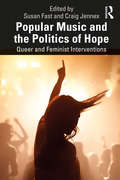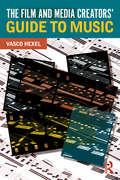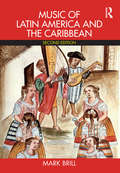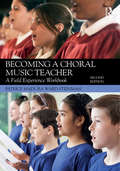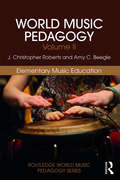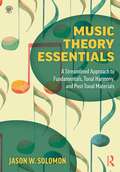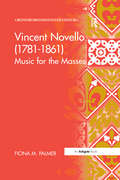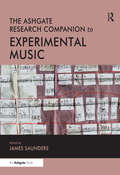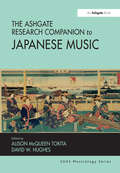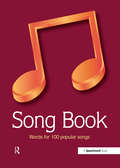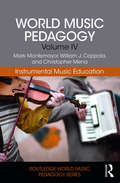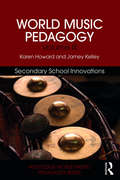- Table View
- List View
Popular Music and the Politics of Hope: Queer and Feminist Interventions
by Susan Fast Craig JennexIn today’s culture, popular music is a vital site where ideas about gender and sexuality are imagined and disseminated. Popular Music and the Politics of Hope: Queer and Feminist Interventions explores what that means with a wide-ranging collection of chapters that consider the many ways in which contemporary pop music performances of gender and sexuality are politically engaged and even radical. With analyses rooted in feminist and queer thought, contributors explore music from different genres and locations, including Beyoncé’s Lemonade, A Tribe Called Red’s We Are the Halluci Nation, and celebrations of Vera Lynn’s 100th Birthday. At a bleak moment in global politics, this collection focuses on the concept of critical hope: the chapters consider making and consuming popular music as activities that encourage individuals to imagine and work toward a better, more just world. Addressing race, class, aging, disability, and colonialism along with gender and sexuality, the authors articulate the diverse ways popular music can contribute to the collective political projects of queerness and feminism. With voices from senior and emerging scholars, this volume offers a snapshot of today’s queer and feminist scholarship on popular music that is an essential read for students and scholars of music and cultural studies.
The Film and Media Creators' Guide to Music
by Vasco HexelMusic plays an integral role in the experience of film, television, video games, and other media—yet for many directors, producers, and media creators, working with music can be a baffling and intimidating process. The Film and Media Creators’ Guide to Music bridges the gap between musical professionals and the creators of film and other media projects, establishing a shared language while demystifying this collaborative journey. Organized with a modular chapter structure, the book covers fundamental topics including: Why (and when) to use music in a project How to talk about music Licensing existing music Commissioning original music Working with a composer Geared toward emerging and established creators alike, this book takes a practical approach to the process of finding the best music for all forms of moving image. The Film and Media Creators’ Guide to Music offers hands-on advice for media creators, providing readers with the confidence to approach the planning, commissioning, creation, and placement of music in their projects with the awareness, understanding, and vocabulary that will enable them to be better collaborators and empowered storytellers. For students and professionals working across film and media, this book is the essential guide to using music creatively and effectively.
The Film and Media Creators' Guide to Music
by Vasco HexelMusic plays an integral role in the experience of film, television, video games, and other media—yet for many directors, producers, and media creators, working with music can be a baffling and intimidating process. The Film and Media Creators’ Guide to Music bridges the gap between musical professionals and the creators of film and other media projects, establishing a shared language while demystifying this collaborative journey. Organized with a modular chapter structure, the book covers fundamental topics including: Why (and when) to use music in a project How to talk about music Licensing existing music Commissioning original music Working with a composer Geared toward emerging and established creators alike, this book takes a practical approach to the process of finding the best music for all forms of moving image. The Film and Media Creators’ Guide to Music offers hands-on advice for media creators, providing readers with the confidence to approach the planning, commissioning, creation, and placement of music in their projects with the awareness, understanding, and vocabulary that will enable them to be better collaborators and empowered storytellers. For students and professionals working across film and media, this book is the essential guide to using music creatively and effectively.
Music of Latin America and the Caribbean
by Mark BrillMusic of Latin America and the Caribbean, Second Edition is a comprehensive textbook for undergraduate students, which covers all major facets of Latin American music, finding a balance between important themes and illustrative examples. This book is about enjoying the music itself and provides a lively, challenging discussion complemented by stimulating musical examples couched in an appropriate cultural and historical context—the music is a specific response to the era from which it emerges, evolving from common roots to a wide variety of musical traditions. Music of Latin America and the Caribbean aims to develop an understanding of Latin American civilization and its relation to other cultures. NEW to this edition A new chapter overviewing all seven Central American countries An expansion of the chapter on the English- and French-speaking Caribbean An added chapter on transnational genres An end-of-book glossary featuring bolded terms within the text A companion website with over 50 streamed or linked audio tracks keyed to Listening Examples found in the text, in addition to other student and instructors’ resources Bibliographic suggestions at the end of each chapter, highlighting resources for further reading, listening, and viewing Organized along thematic, historical, and geographical lines, Music of Latin America and the Caribbean implores students to appreciate the unique and varied contributions of other cultures while realizing the ways non-Western cultures have influenced Western musical heritage. With focused discussions on genres and styles, musical instruments, important rituals, and the composers and performers responsible for its evolution, the author employs a broad view of Latin American music: every country in Latin America and the Caribbean shares a common history, and thus, a similar musical tradition.
Music of Latin America and the Caribbean
by Mark BrillMusic of Latin America and the Caribbean, Second Edition is a comprehensive textbook for undergraduate students, which covers all major facets of Latin American music, finding a balance between important themes and illustrative examples. This book is about enjoying the music itself and provides a lively, challenging discussion complemented by stimulating musical examples couched in an appropriate cultural and historical context—the music is a specific response to the era from which it emerges, evolving from common roots to a wide variety of musical traditions. Music of Latin America and the Caribbean aims to develop an understanding of Latin American civilization and its relation to other cultures. NEW to this edition A new chapter overviewing all seven Central American countries An expansion of the chapter on the English- and French-speaking Caribbean An added chapter on transnational genres An end-of-book glossary featuring bolded terms within the text A companion website with over 50 streamed or linked audio tracks keyed to Listening Examples found in the text, in addition to other student and instructors’ resources Bibliographic suggestions at the end of each chapter, highlighting resources for further reading, listening, and viewing Organized along thematic, historical, and geographical lines, Music of Latin America and the Caribbean implores students to appreciate the unique and varied contributions of other cultures while realizing the ways non-Western cultures have influenced Western musical heritage. With focused discussions on genres and styles, musical instruments, important rituals, and the composers and performers responsible for its evolution, the author employs a broad view of Latin American music: every country in Latin America and the Caribbean shares a common history, and thus, a similar musical tradition.
Becoming a Choral Music Teacher: A Field Experience Workbook
by Patrice Madura Ward-SteinmanBecoming a Choral Music Teacher: A Field Experience Workbook, Second Edition is a choral methods textbook that prepares students in Music Education to become middle school and high school choral music teachers. It emphasizes important musical skills, vocal pedagogy and repertoire suitable for secondary school choirs in order to provide future teachers with the critical experiences to be effective. Focusing equally on rehearsal strategies, auditions and classroom management, the book is also a "workbook" that requires the students’ active learning through participation in fieldwork. Students learn in a sequential and practical manner, beginning with the study of the middle school voice and progressing to the high school voice, through practice of theory with adolescents, followed by class reflection on common problems and solutions, and then continued practice. NEW to this Edition Updated references to NAfME, and new national and state standards and licensing rules More on the needs of Special Learners in the choral classroom Latest resources on classroom management theories and practice Expanded vocal warm-ups that incorporate body movement and aural skills training More on gender issues (including LGBT awareness), sociological impact and meanings of choral singing, and emerging knowledge of multicultural choral music Becoming a Choral Music Teacher: A Field Experience Workbook, Second Edition fully integrates the choral field experience for hands-on learning and reflection and allows the student to observe and teach the book’s principles.
Becoming a Choral Music Teacher: A Field Experience Workbook
by Patrice Madura Ward-SteinmanBecoming a Choral Music Teacher: A Field Experience Workbook, Second Edition is a choral methods textbook that prepares students in Music Education to become middle school and high school choral music teachers. It emphasizes important musical skills, vocal pedagogy and repertoire suitable for secondary school choirs in order to provide future teachers with the critical experiences to be effective. Focusing equally on rehearsal strategies, auditions and classroom management, the book is also a "workbook" that requires the students’ active learning through participation in fieldwork. Students learn in a sequential and practical manner, beginning with the study of the middle school voice and progressing to the high school voice, through practice of theory with adolescents, followed by class reflection on common problems and solutions, and then continued practice. NEW to this Edition Updated references to NAfME, and new national and state standards and licensing rules More on the needs of Special Learners in the choral classroom Latest resources on classroom management theories and practice Expanded vocal warm-ups that incorporate body movement and aural skills training More on gender issues (including LGBT awareness), sociological impact and meanings of choral singing, and emerging knowledge of multicultural choral music Becoming a Choral Music Teacher: A Field Experience Workbook, Second Edition fully integrates the choral field experience for hands-on learning and reflection and allows the student to observe and teach the book’s principles.
World Music Pedagogy, Volume II: Elementary Music Education (Routledge World Music Pedagogy Series)
by J. Christopher Roberts Amy C. BeegleWorld Music Pedagogy, Volume II: Elementary Music Education delves into the theory and practices of World Music Pedagogy with children in grades 1-6 (ages 6-12). It specifically addresses how World Music Pedagogy applies to the characteristic learning needs of elementary school children: this stage of a child’s development—when minds are opening up to broader perspectives on the world—presents opportunities to develop meaningful multicultural understanding alongside musical knowledge and skills that can last a lifetime. This book is not simply a collection of case studies but rather one that offers theory and practical ideas for teaching world music to children. Classroom scenarios, along with teaching and learning experiences, are presented within the frame of World Music Pedagogy. Ethnomusicological issues of authenticity, representation, and context are addressed and illustrated, supporting the ultimate goal of helping children better understand their world through music.
World Music Pedagogy, Volume II: Elementary Music Education (Routledge World Music Pedagogy Series)
by J. Christopher Roberts Amy C. BeegleWorld Music Pedagogy, Volume II: Elementary Music Education delves into the theory and practices of World Music Pedagogy with children in grades 1-6 (ages 6-12). It specifically addresses how World Music Pedagogy applies to the characteristic learning needs of elementary school children: this stage of a child’s development—when minds are opening up to broader perspectives on the world—presents opportunities to develop meaningful multicultural understanding alongside musical knowledge and skills that can last a lifetime. This book is not simply a collection of case studies but rather one that offers theory and practical ideas for teaching world music to children. Classroom scenarios, along with teaching and learning experiences, are presented within the frame of World Music Pedagogy. Ethnomusicological issues of authenticity, representation, and context are addressed and illustrated, supporting the ultimate goal of helping children better understand their world through music.
Music Theory Essentials: A Streamlined Approach to Fundamentals, Tonal Harmony, and Post-Tonal Materials
by Jason W. SolomonMusic Theory Essentials offers an antidote to music theory textbooks that are overly long and dense. Focusing on the essentials, this text provides a clear-cut guide to the key concepts of music theory. Beginning with no assumptions about music theory knowledge, the book covers the core elements of music fundamentals, diatonic and chromatic harmony, post-tonal theory, and popular music in a single concise volume. Emphasizing critical thinking skills, this book guides students through conceptualizing musical concepts and mastering analytic techniques. Each chapter concludes with a selection of applications designed to enhance engagement: Exercises allow students to apply and practice the skills and techniques addressed in the chapter. Brain Teasers challenge students to expand their musical understanding by thinking outside the box. Exploring Music offers strategies for students to apply learned concepts to the music they are currently learning or listening to. Thinking Critically encourages students to think more deeply about music by solving problems and identifying and challenging assumptions. A companion website provides answers to book exercises, additional downloadable exercises, and audio examples. Straightforward and streamlined, Music Theory Essentials is a truly concise yet comprehensive introduction to music theory that is accessible to students of all backgrounds.
Music Theory Essentials: A Streamlined Approach to Fundamentals, Tonal Harmony, and Post-Tonal Materials
by Jason W. SolomonMusic Theory Essentials offers an antidote to music theory textbooks that are overly long and dense. Focusing on the essentials, this text provides a clear-cut guide to the key concepts of music theory. Beginning with no assumptions about music theory knowledge, the book covers the core elements of music fundamentals, diatonic and chromatic harmony, post-tonal theory, and popular music in a single concise volume. Emphasizing critical thinking skills, this book guides students through conceptualizing musical concepts and mastering analytic techniques. Each chapter concludes with a selection of applications designed to enhance engagement: Exercises allow students to apply and practice the skills and techniques addressed in the chapter. Brain Teasers challenge students to expand their musical understanding by thinking outside the box. Exploring Music offers strategies for students to apply learned concepts to the music they are currently learning or listening to. Thinking Critically encourages students to think more deeply about music by solving problems and identifying and challenging assumptions. A companion website provides answers to book exercises, additional downloadable exercises, and audio examples. Straightforward and streamlined, Music Theory Essentials is a truly concise yet comprehensive introduction to music theory that is accessible to students of all backgrounds.
Vincent Novello: Music for the Masses (Music in Nineteenth-Century Britain)
by Fiona M. PalmerToday Vincent Novello (1781-1861) is remembered as the father of the music-publishing firm. Fiona Palmer's evaluation of Novello the man and the musician in the marketplace draws on rich primary sources. It is the first to provide a rounded view of his life and work, and the nature of his importance both in his own time and to posterity. Novello's early musical training, particularly his experience of music-making in London's embassy chapels, influenced him profoundly. His practical experience as director of music at the Portuguese Embassy Chapel in Mayfair informed his approach to editing and arranging. Fundamental moral and social attitudes underpinned Novello's progress. Ideas on religion, education and the function of family and friendship within society shaped his life choices. The Novello family lived in turbulent times and was widely-read, discussing politics and religion and not only the arts at its social gatherings. Within Vincent and Mary Novello's close circle were radical thinkers with republican views - such as Leigh Hunt and Charles Cowden Clarke - who saw sociability as a means of reorganizing society. Thematic studies focus on Novello as practical musician and educator, as editor, and as composer. His connections with institutions such as the Covent Garden and Pantheon Theatres, the Philharmonic Society and Moorfields Chapel, together with his adjudicating and teaching activities, are examined. In his wide-ranging editorial work Novello found his true vocation positioning himself as preservationist, pioneer and philanthropist. His work as composer, though unremarkable in quality, mirrored the demands and expectations of his consumers. Novello emerges from this study as a visionary who single-mindedly pursued greater musical knowledge for the benefit of everyone.
Vincent Novello: Music for the Masses (Music in Nineteenth-Century Britain)
by Fiona M. PalmerToday Vincent Novello (1781-1861) is remembered as the father of the music-publishing firm. Fiona Palmer's evaluation of Novello the man and the musician in the marketplace draws on rich primary sources. It is the first to provide a rounded view of his life and work, and the nature of his importance both in his own time and to posterity. Novello's early musical training, particularly his experience of music-making in London's embassy chapels, influenced him profoundly. His practical experience as director of music at the Portuguese Embassy Chapel in Mayfair informed his approach to editing and arranging. Fundamental moral and social attitudes underpinned Novello's progress. Ideas on religion, education and the function of family and friendship within society shaped his life choices. The Novello family lived in turbulent times and was widely-read, discussing politics and religion and not only the arts at its social gatherings. Within Vincent and Mary Novello's close circle were radical thinkers with republican views - such as Leigh Hunt and Charles Cowden Clarke - who saw sociability as a means of reorganizing society. Thematic studies focus on Novello as practical musician and educator, as editor, and as composer. His connections with institutions such as the Covent Garden and Pantheon Theatres, the Philharmonic Society and Moorfields Chapel, together with his adjudicating and teaching activities, are examined. In his wide-ranging editorial work Novello found his true vocation positioning himself as preservationist, pioneer and philanthropist. His work as composer, though unremarkable in quality, mirrored the demands and expectations of his consumers. Novello emerges from this study as a visionary who single-mindedly pursued greater musical knowledge for the benefit of everyone.
The Ashgate Research Companion to Experimental Music (Routledge Music Companions)
by James SaundersThe recent resurgence of experimental music has given rise to a more divergent range of practices than has previously been the case. The Ashgate Research Companion to Experimental Music reflects these recent developments by providing examples of current thinking and presenting detailed case studies that document the work of contemporary figures. The book examines fourteen current practitioners by interrogating their artistic practices through annotated interviews, contextualized by nine authored chapters which explore central issues that emerge from and inform these discussions. Whilst focusing on composition, the book also encompasses related aspects of performance, improvisation and sonic art. The interviews all explore how the selected artists work, focusing on the processes involved in developing their recent projects, set against more general aesthetic concerns. They aim to shed light on the disparate nature of current work whilst seeking to find possible points of contact. Many of the practitioners are active in areas that span disciplines, such as composition and improvisation, and the book explores the interaction of these activities in the context of their work. The other chapters consider a range of issues pertinent to recent developments in the genre, including: definitions of experimentalism and its relationship with a broader avant garde; experimentalism and cultural change; notation and its effect on composition; realising open scores; issues of notation and interpretation in live electronic music; performing experimental music; improvisation and technology; improvisation and social meaning; instrumentalizing objects; visual artists' relationships to experimental music; working across interdisciplinary boundaries; listening and the soundscape; working methods, techniques and aesthetics of recent experimental music.
The Ashgate Research Companion to Experimental Music (Routledge Music Companions)
by James SaundersThe recent resurgence of experimental music has given rise to a more divergent range of practices than has previously been the case. The Ashgate Research Companion to Experimental Music reflects these recent developments by providing examples of current thinking and presenting detailed case studies that document the work of contemporary figures. The book examines fourteen current practitioners by interrogating their artistic practices through annotated interviews, contextualized by nine authored chapters which explore central issues that emerge from and inform these discussions. Whilst focusing on composition, the book also encompasses related aspects of performance, improvisation and sonic art. The interviews all explore how the selected artists work, focusing on the processes involved in developing their recent projects, set against more general aesthetic concerns. They aim to shed light on the disparate nature of current work whilst seeking to find possible points of contact. Many of the practitioners are active in areas that span disciplines, such as composition and improvisation, and the book explores the interaction of these activities in the context of their work. The other chapters consider a range of issues pertinent to recent developments in the genre, including: definitions of experimentalism and its relationship with a broader avant garde; experimentalism and cultural change; notation and its effect on composition; realising open scores; issues of notation and interpretation in live electronic music; performing experimental music; improvisation and technology; improvisation and social meaning; instrumentalizing objects; visual artists' relationships to experimental music; working across interdisciplinary boundaries; listening and the soundscape; working methods, techniques and aesthetics of recent experimental music.
The Ashgate Research Companion to Japanese Music (SOAS Studies in Music)
by David W. HughesMusic is a frequently neglected aspect of Japanese culture. It is in fact a highly problematic area, as the Japanese actively introduced Western music into their modern education system in the Meiji period (1868-1911), creating westernized melodies and instrumental instruction for Japanese children from kindergarten upwards. As a result, most Japanese now have a far greater familiarity with Western (or westernized) music than with traditional Japanese music. Traditional or classical Japanese music has become somewhat ghettoized, often known and practised only by small groups of people in social structures which have survived since the pre-modern era. Such marginalization of Japanese music is one of the less recognized costs of Japan's modernization. On the other hand, music in its westernized and modernized forms has an extremely important place in Japanese culture and society, Beethoven's Ninth Symphony, for example, being so widely known and performed that it is arguably part of contemporary Japanese popular and mass culture. Japan has become a world leader in the mass production of Western musical instruments and in innovative methodologies of music education (Yamaha and Suzuki). More recently, the Japanese craze of karaoke as a musical entertainment and as musical hardware has made an impact on the leisure and popular culture of many countries in Asia, Europe and the Americas. This is the first book to cover in detail all genres including court music, Buddhist chant, theatre music, chamber ensemble music and folk music, as well as contemporary music and the connections between music and society in various periods. The book is a collaborative effort, involving both Japanese and English speaking authors, and was conceived by the editors to form a balanced approach that comprehensively treats the full range of Japanese musical culture.
The Ashgate Research Companion to Japanese Music (SOAS Studies in Music)
by David W. HughesMusic is a frequently neglected aspect of Japanese culture. It is in fact a highly problematic area, as the Japanese actively introduced Western music into their modern education system in the Meiji period (1868-1911), creating westernized melodies and instrumental instruction for Japanese children from kindergarten upwards. As a result, most Japanese now have a far greater familiarity with Western (or westernized) music than with traditional Japanese music. Traditional or classical Japanese music has become somewhat ghettoized, often known and practised only by small groups of people in social structures which have survived since the pre-modern era. Such marginalization of Japanese music is one of the less recognized costs of Japan's modernization. On the other hand, music in its westernized and modernized forms has an extremely important place in Japanese culture and society, Beethoven's Ninth Symphony, for example, being so widely known and performed that it is arguably part of contemporary Japanese popular and mass culture. Japan has become a world leader in the mass production of Western musical instruments and in innovative methodologies of music education (Yamaha and Suzuki). More recently, the Japanese craze of karaoke as a musical entertainment and as musical hardware has made an impact on the leisure and popular culture of many countries in Asia, Europe and the Americas. This is the first book to cover in detail all genres including court music, Buddhist chant, theatre music, chamber ensemble music and folk music, as well as contemporary music and the connections between music and society in various periods. The book is a collaborative effort, involving both Japanese and English speaking authors, and was conceived by the editors to form a balanced approach that comprehensively treats the full range of Japanese musical culture.
Song Book: Words for 100 Popular Songs
by Ffion Mercer Speechmark SpeechmarkFeaturing large clear print, the "Song Book" contains the words to 100 popular songs that are ideal for group sing-along sessions. The book is divided into six sections: traditional folk songs, choruses from old time variety, songs from World War II, post-war evergreens, hymns, and Christmas songs.
Song Book: Words for 100 Popular Songs
by Ffion Mercer Speechmark SpeechmarkFeaturing large clear print, the "Song Book" contains the words to 100 popular songs that are ideal for group sing-along sessions. The book is divided into six sections: traditional folk songs, choruses from old time variety, songs from World War II, post-war evergreens, hymns, and Christmas songs.
World Music Pedagogy, Volume IV: Teaching World Music In Higher Education (Routledge World Music Pedagogy Series)
by Mark Montemayor William Coppola Christopher MenaWorld Music Pedagogy, Volume IV: Instrumental Music Education provides the perspectives and resources to help music educators craft world-inclusive instrumental music programs in their teaching practices. Given that school instrumental music programs—concert bands, symphony orchestras, and related ensembles—have borne musical traditions that broadly reflect Western art music and military bands, instructors are often educated within the European conservatory framework. Yet a culturally diverse and inclusive music pedagogy can enrich, expand, and transform these instrumental music programs to great effect.Drawing from years of experience as practicing music educators and band and orchestra leaders, the authors present a vision characterized by both real-world applicability and a great depth of perspective. Lesson plans, rehearsal strategies, and vignettes from practicing teachers constitute valuable resources. With carefully tuned ears to intellectual currents throughout the broader music education community, World Music Pedagogy, Volume IV provides readers with practical approaches and strategies for creating world-inclusive instrumental music programs.
World Music Pedagogy, Volume IV: Instrumental Music Education (Routledge World Music Pedagogy Series)
by Mark Montemayor William Coppola Christopher MenaWorld Music Pedagogy, Volume IV: Instrumental Music Education provides the perspectives and resources to help music educators craft world-inclusive instrumental music programs in their teaching practices. Given that school instrumental music programs—concert bands, symphony orchestras, and related ensembles—have borne musical traditions that broadly reflect Western art music and military bands, instructors are often educated within the European conservatory framework. Yet a culturally diverse and inclusive music pedagogy can enrich, expand, and transform these instrumental music programs to great effect.Drawing from years of experience as practicing music educators and band and orchestra leaders, the authors present a vision characterized by both real-world applicability and a great depth of perspective. Lesson plans, rehearsal strategies, and vignettes from practicing teachers constitute valuable resources. With carefully tuned ears to intellectual currents throughout the broader music education community, World Music Pedagogy, Volume IV provides readers with practical approaches and strategies for creating world-inclusive instrumental music programs.
World Music Pedagogy, Volume III: Secondary School Innovations (Routledge World Music Pedagogy Series)
by Karen Howard Jamey KelleyWorld Music Pedagogy, Volume III: Secondary School Innovations provides a rationale and a resource for the implementation of World Music Pedagogy in middle and high school music classes, grades 7–12 (ages 13–18). Such classes include secondary general music, piano, guitar, songwriting, composition/improvisation, popular music, world music, music technology, music production, music history, and music theory courses. This book is not a depository of ready-made lesson plans but rather a tool to help middle and high school teachers to think globally in the music classroom. Strategies and techniques of World Music Pedagogy are promoted by discussions of a multicultural music education, descriptive vignettes of realistic teaching environments, conversations with culture-bearers/pedagogues, and prompts for self-reflection. This volume approaches important issues of multicultural education and social justice that are often neglected in music education texts—proving to be a valuable resource for both nascent music educators and veteran practitioners alike.
World Music Pedagogy, Volume III: Secondary School Innovations (Routledge World Music Pedagogy Series)
by Karen Howard Jamey KelleyWorld Music Pedagogy, Volume III: Secondary School Innovations provides a rationale and a resource for the implementation of World Music Pedagogy in middle and high school music classes, grades 7–12 (ages 13–18). Such classes include secondary general music, piano, guitar, songwriting, composition/improvisation, popular music, world music, music technology, music production, music history, and music theory courses. This book is not a depository of ready-made lesson plans but rather a tool to help middle and high school teachers to think globally in the music classroom. Strategies and techniques of World Music Pedagogy are promoted by discussions of a multicultural music education, descriptive vignettes of realistic teaching environments, conversations with culture-bearers/pedagogues, and prompts for self-reflection. This volume approaches important issues of multicultural education and social justice that are often neglected in music education texts—proving to be a valuable resource for both nascent music educators and veteran practitioners alike.
Gateways to Understanding Music
by Timothy Rice Dave WilsonGateways to Understanding Music explores music in all the categories that constitute contemporary musical experience: European classical music, popular music, jazz, and world music. Covering the oldest forms of human music making to the newest, the chronological narrative considers music from a global rather than a Eurocentric perspective. Each of sixty modular "gateways" covers a particular genre, style, or period of music. Every gateway opens with a guided listening example that unlocks a world of music through careful study of its structural elements. Based on their listening experience, students are asked to consider how the piece came to be composed or performed, how the piece or performance responded to the social and cultural issues at the time and place of its creation, and what that music means today. Students learn to listen to, explain, understand, and ultimately value all the music they may encounter in their world. FEATURES Global scope—Presents all music as worthy of study, including classical, world, popular, and jazz. Historical narrative—Begins with small-scale forager societies up to the present, with a shifting focus from global to European to American influences. Modular framework—60 gateways in 14 chapters allow flexibility to organize chronologically or by the seven recurring themes: aesthetics, emotion, social life, links to culture, politics, economics, and technology. Listening-guided learning—Leads to understanding the emotion, meaning, significance, and history of music. Introduction of musical concepts—Defined as needed and compiled into a Glossary for reference. Consistent structure—With the same step-by-step format, students learn through repeated practice how to listen and how to think about music. In addition to streamed audio examples, the companion website hosts essential instructors’ resources.
Gateways to Understanding Music
by Timothy Rice Dave WilsonGateways to Understanding Music explores music in all the categories that constitute contemporary musical experience: European classical music, popular music, jazz, and world music. Covering the oldest forms of human music making to the newest, the chronological narrative considers music from a global rather than a Eurocentric perspective. Each of sixty modular "gateways" covers a particular genre, style, or period of music. Every gateway opens with a guided listening example that unlocks a world of music through careful study of its structural elements. Based on their listening experience, students are asked to consider how the piece came to be composed or performed, how the piece or performance responded to the social and cultural issues at the time and place of its creation, and what that music means today. Students learn to listen to, explain, understand, and ultimately value all the music they may encounter in their world. FEATURES Global scope—Presents all music as worthy of study, including classical, world, popular, and jazz. Historical narrative—Begins with small-scale forager societies up to the present, with a shifting focus from global to European to American influences. Modular framework—60 gateways in 14 chapters allow flexibility to organize chronologically or by the seven recurring themes: aesthetics, emotion, social life, links to culture, politics, economics, and technology. Listening-guided learning—Leads to understanding the emotion, meaning, significance, and history of music. Introduction of musical concepts—Defined as needed and compiled into a Glossary for reference. Consistent structure—With the same step-by-step format, students learn through repeated practice how to listen and how to think about music. In addition to streamed audio examples, the companion website hosts essential instructors’ resources.
